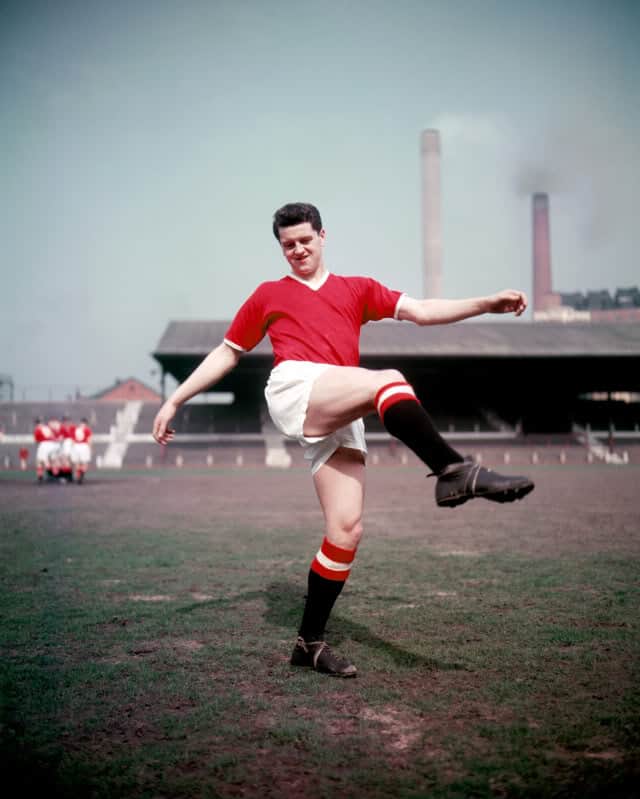Tommy Taylor was a part of Sir Matt Busby’s legendary Manchester United team of the late 1950s, and he was one of the lives tragically lost in the snow at Munich Airport. He was a center-forward who was consistently prolific, but who was equally renowned for setting up chances for his strike partners.
Fellow striker Jimmy Greaves described Taylor as: ‘a truly great center-forward. This fellow would have stood out in any era, great players always would, and he was a brilliant player with bags of old-fashioned guts.’ Sir Bobby Charlton explains that Taylor ‘…was very fast, immensely strong, and… was absolutely sensational in the air.’ I have entitled this article ‘The Greatest Center-Forward’ with deliberate ambiguity, in that the words ‘of his era’ might be added by some. Others might believe that given all of the obstacles Taylor faced, and the astonishing career he carved out for himself in a very short time, the title stands as a statement of fact. Once you have read his story you may have your own opinion, but, whatever you decide, his was a footballing life that all United fans, and indeed all football fans, should be aware of.
Tommy Taylor – Early Life
In the period between the two World Wars, coal was the major source of energy in Britain. It was used to heat homes, produce electricity and gas, and even powered the railways. Yorkshire was the site of the nation’s most important coalfields, so the county was inevitably dominated by mining. The work was unpleasant, but it engendered a strong community spirit. Mineworkers would socialize together, and many developed a passion for football. Charles Taylor was a miner who also played football at a good local level: his father Thomas had played for Barnsley. Charles married Violet Hodgkis in 1921, and despite the loss of their first son at a young age, they went on to have six further children. The fifth of these was Thomas, born on 29 January 1932. Young Tommy soon became known as ‘Tucker’, after the nursery rhyme character ‘Little Tommy Tucker’.
Tommy’s parents worked hard to make ends meet, and he certainly did not grow up in luxury. At school he was average. He did not pass the 11-plus, so he attended Raley Secondary Modern School. Raley was not an outstanding school from an academic viewpoint, but it did boast good sports facilities, which made it ideal for Tommy. His contemporaries included Harold ‘Dickie’ Bird, who went on to be a cricketer and umpire. Tommy soon progressed to the school football team, and between the ages of 12 and 14 he was chosen to play for Barnsley Boys. One curiosity of this time was the fact that Tommy did not own a pair of football boots: he would simply borrow some when he needed them. This may have been due to financial constraints, but whatever the reason, when he arrived for a school match in his final year without any boots, he was told to play in his clogs. Upon refusing, he was sent home, and never played for the school again.
While Tommy loved football and knew he had talent, he did not make any attempt at this point to follow it as a career. To understand this, it is necessary to remember that football was not the path to limitless wealth that it can appear today. Players earned the same as other working people, and, whilst there were many worse ways to make a living, it was a lot easier to just ‘get a job’. At 14, Tommy left school to get a job as a surface worker at Wharncliff Colliery, and he would continue in this role for two years. He still enjoyed an occasional kickabout with his friends, but otherwise, football was completely off the agenda.
Tommy’s football career could easily, therefore, have never got started. However, a local team, Smithies United, based at the pub where his mother worked, found themselves a player short for a local cup tie and asked him to play. This was one of those ‘sliding doors’ moments. If he had declined, he may never have played football competitively again, and he might still be living a quiet life in Barnsley. Tommy decided to play, however, and enjoyed the game. Clearly he had not lost his touch, because he was asked to play again, and after two appearances, scouts from Barnsley and Hull were inviting him for a trial. Tommy felt that Hull was too far to travel, so Barnsley was his first choice, and after a successful trial, he was invited to join the ground staff at Oakwell. A transfer fee of £10 was paid to Smithies, which, considering that he only ever played for them three times, and was not properly registered prior to his first appearance, was not ungenerous.
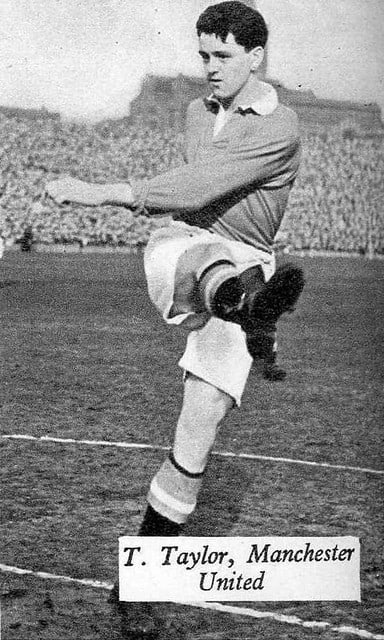
Tommy Taylor- Barnsley and National Service
Tommy Taylor arrived at Oakwell on 7 February 1948 and signed amateur forms. Times have clearly changed since then, but even in post-war Britain, it must have been very unusual for a professional football club to sign a youngster who had played three competitive games in the preceding two years. The Youth Team Trainer at the time was Johnny Steele, and he was nonetheless immediately impressed with Taylor’s potential. He later recalled Tommy’s great heading ability and long stride, allied to good ball-striking. At this stage, Steele noted, the young man could be a little clumsy on the ball and needed to work on his turns, but Tommy was enthusiastic and had a good work ethic. His mischievous personality made him a popular figure among the other players. Steele also observed that initially: ‘Tommy carried a little too much ‘puppy fat’ but we advised him about his eating habits. He listened and acted accordingly. And he wasn’t very tall either at that time’.
The completely untrained talent within Taylor was now, for the first time, subject to professional coaching and discipline, and his improvement was rapid. In his first year, he played for the club’s ‘B’ team, moving up to the ‘A’ team in his second. On 25 July 1949, Tommy signed professional forms, 18 months after taking up the game again. Unfortunately, there were plenty more difficulties to be overcome before he could reach the top. Towards the end of the 1949/50 season, he was called up for his National Service. By this time, the staff at Barnsley had realized that Taylor had the potential to be an outstanding player, so the Chairman, Joe Richards, hatched a scheme by means of which he could circumvent this call-up. If Tommy was given a job at the local pit, this would exempt him from National Service, and he could stay at Barnsley. When this was put to the young striker, however, he refused the offer, preferring to complete his National Service. It is not known whether this was a result of a sense of duty or a dislike of mine work, but, either way, he entered service on 25 May 1950 with the Royal Artillery at Oswestry.
At first, serving in the Army seemed to be of benefit to Taylor. He grew two inches taller, but the physical training meant that he developed a much more muscular and imposing physique to go along with this new height. In football terms, the Army offered a range of matches at different levels, some of which were of a high standard and incorporated international travel. Others, however, were against inferior players who could be very physical. Tommy was still sometimes available to play for Barnsley, and on 7 October 1950, he made his first-team debut against Grimsby in a 3-1 win. A couple of weeks later he played again, in a home match against QPR, and on this occasion seized the limelight by scoring a hat-trick. Taylor managed 12 appearances for Barnsley in 1950/51 and scored 7 goals.
Early in the 1951/2 season, the roughness of some of the Army football caused a major issue for Taylor. Playing against a team from the North Staffordshire Regiment, he clashed with the opposing goalkeeper and suffered a potentially career-ending knee injury. This was basically the end of Army football for him, as two operations and an 11-month lay-off ensued. Advice from a Newcastle-based specialist and determined rehabilitation eventually helped him recover, and, after leaving the Army in 1952, he was able to prepare wholeheartedly for the 1952/53 season. When matches got underway, Tommy felt good, but nothing went right for Barnsley. He started the season in his previous position of inside-left, but by Christmas, he had moved to center-forward, a position in which he immediately felt more comfortable. Following a 3-1 defeat at Sheffield United, however, manager Angus Seed decided to drop Tommy to the reserves for a midweek match against Manchester United. This was another ‘sliding doors’ moment, because Tommy dominated this match, scoring an impressive hat-trick and impressing United Assistant Manager Jimmy Murphy. This brought him to the attention of United’s hierarchy, but if Seed had not dropped him, would the Old Trafford club ever have pursued him? In any event, this performance earned him his first-team place back for the following Saturday.
Despite Taylor’s good form, which would ultimately earn him 19 goals from 28 matches, Barnsley continued to struggle in Division 2. Following an FA Cup tie at Plymouth, Angus Seed was taken ill and died. Financial difficulties were mounting, and at the end of February, the Board decided to put Tommy on the transfer list. This quickly sparked a bidding war, as his reputation had grown by this time. Eventually, it came down to a head-to-head battle between Cardiff and Manchester United. Cardiff offered what would have been a record transfer fee of £35,000, but Tommy was reluctant to move somewhere so far from home. Given this, Richards knew that his task was to negotiate a good deal with United manager Matt Busby. Ultimately, a fee of £30,000 was settled upon, with Tommy agreeing to sign once he had been given the option of continuing to train at Oakwell, and been promised some tickets for his family. Famously, Busby did not want the young man to be saddled with the label of being a £30,000 player, so he persuaded Barnsley to accept £29,999, and paid the other £1 to tea lady Lily Wilby. Whether this ploy resulted in less publicity or more is, of course, questionable, but Busby’s intention to protect Taylor is clear. Tommy finally signed for United on 4 March 1953.
Tommy Taylor- The United Years
The day after signing, Tommy visited Old Trafford for the first time with girlfriend Norma Curtis. They were given a tour and liked what they saw, so the following day Tommy returned to Manchester for good. He never exercised his right to remain based at Oakwell. To get to Manchester, he took the train, and carried his boots in a brown paper bag- a slightly different image from that presented by many big-money signings these days!
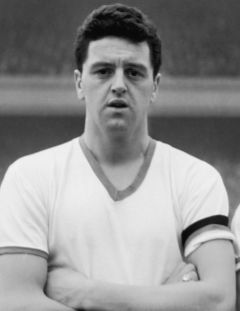
Matt Busby and Jimmy Murphy were excited by the potential of the young Yorkshireman. He was already good enough to be a threat to First Division defenses, despite having played far less football than most of his contemporaries. They knew that, with a little work, he could become a true world-beater. One of the first things Murphy worked on was Taylor’s first touch and ball control, which could occasionally let him down. Tommy always listened and worked hard, so improvements were quickly evident.
Taylor made his United debut just three days after signing, on 7 March 1953, in a home game against Preston. The match could hardly have gone better, as he scored twice in a 5-2 victory. This performance led George Follows, in the Manchester Evening News, to coin the nickname ‘the smiling executioner’ for the young man from Barnsley. This was a time of transition for United, as some of their older players were reaching the end of their top-level careers. There were a lot of promising youngsters waiting in the wings, and, while Busby knew that not all of them were yet ready for the first team, he began to gradually introduce them in the latter part of the season. Tommy finished the season with 7 goals in 11 games for United, and the team achieved a respectable 8th place.
To cap Taylor’s meteoric rise, the England selectors invited him to join the national team on their tour of North and South America. Tommy played matches against Argentina, Chile, and Uruguay, scoring in each. His team-mates were impressed with his courage and maturity, and Taylor, in turn, was grateful for the opportunity to play with and against some of the best players in the world. He also had the chance to meet luminaries such as Juan Peron and Cary Grant, and it was these experiences that dominated his recollections when he returned to Smithies. Tommy never spent a great deal of time talking about football with his family and friends. He vowed to work hard to continue to improve and to show himself to be worthy of the recognition that he was now getting.
The 1953/54 season did not start as United might have hoped, with their first win coming in their 9th match, against Middlesbrough. The realization gradually dawned on Busby that it was time to make a more concerted switch to a strategy based on youth. The match against Huddersfield on 31 October marked a watershed and is regarded as the first match played by the group known as the ‘Busby Babes’, featuring, as it did, seven players under the age of 21. Around this time, the man who was to become Taylor’s most successful strike partner, Dennis Viollet, became a regular in the side. Viollet was a mobile, lightweight striker, who provided the perfect foil for the big Yorkshireman. Because Viollet was so slight, Busby asked Tommy to look after him on the field, and the manager could not help but be impressed by the maturity with which the 21-year old handled this responsibility.
As the 1953/54 season progressed, United’s performances improved, and Taylor was close to the top of his game. Busby was becoming increasingly positive about the future, stating with well-justified confidence: ‘Within two years this young team will be much too good for anything else in the First Division’. There were, of course, still a few hiccups. On 27 March, United lost 3-1 to Arsenal at Highbury. Journalist Henry Rose described Taylor as: ‘the outstanding star of this match’, but unfortunately he sustained what would turn out to be a lingering ankle injury. An operation at the end of March did not really improve matters, but it did ensure that Tommy would have to miss the final six games of the season. Nonetheless, he finished the season as top scorer, with 22 goals from 35 matches, and United achieved a more than respectable fourth-place finish.
Despite the fact that the ankle problem was still troubling him, Taylor was selected to join the England party for the 1954 World Cup in Switzerland. He played in the group games against Belgium and Switzerland, making a solid contribution. He began at inside-left, but in the latter game, in the absence of a sick Nat Lofthouse, he was able to play in his favored position of center-forward for the first time. With Lofthouse available again, and Taylor clearly not 100% fit, Tommy was left out of the quarter-final match against defending champions Uruguay, which England would go on to lose 4-2.
1954/55 would prove to be a rather frustrating season for Taylor. He would miss the first four matches due to his nagging ankle problem. A goalscoring comeback in the next game proved short-lived, as he was then forced to miss the following two. Eventually, Matt Busby took him down to London to see the Queen’s Surgeon, who was able to isolate the problem that United’s medical staff could not find. There was a piece of floating bone in the ankle, which was causing Taylor considerable pain. Once this had been removed by means of a second operation, the striker was on the road to recovery. United was delighted to welcome him back, as the mystery injury had been putting his career in doubt, but the England selectors were less sympathetic, discarding him for around a year. Overall, this was a stop-start season for Taylor, as he struggled to regain full fitness, but he still scored 20 goals in 29 matches.
With Taylor now fully fit, the 1955/56 season was one that he and United were anticipating keenly. Unfortunately, Tommy sustained an injury in the first game of the season which would keep him out for the following seven matches. When he finally returned, however, neither he nor the team looked back. The Barnsley man’s mobility, shooting power, and, most of all, prodigious heading ability provided a cutting edge to the stylish football being played by Busby’s young team. Taylor had always been a strong header of the ball but have noted some of the training techniques used by the Uruguayans he was able to improve his jumping even further. Team-mate John Doherty observes that Tommy was: ‘absolutely outstanding in the air with that ability to ‘float’ and remain apparently suspended for seconds at the top of his leap’. At the end of March, United traveled to Huddersfield in pole position in the league but facing a tough battle against relegation-threatened opponents. Two goals from Taylor inspired the Reds to victory, the second of which, a powerful header from outside the penalty area, was his 100th league goal. This win demonstrated that the young team could handle pressure, and they duly wrapped up the title a week later against Blackpool in front of a packed Old Trafford. Taylor scored the winning goal, and by the time the season was complete, he had accrued an impressive 25 in just 33 games.
Given his impressive domestic form, the England selectors had no choice but to reintroduce Taylor to the full international squad. He gained five more caps over the summer, but his most notable performance was in a friendly against Brazil on 9
May 1956. This brought a dominant 4-2 victory for England, with two goals for Tommy. A European tour followed, which culminated in a victory over World Champions West Germany.
At the start of the 1956/57 season, United felt capable of winning every competition they entered. Busby’s dream was for them to win the European Cup, so, despite the reservations of the Football League, they became the first English club to take part. After a strong start to their league campaign, they faced Anderlecht in the preliminary round. A 2-0 win in Belgium was followed by a 10-0 triumph at Old Trafford, featuring a hat-trick from Tommy. If anyone had questioned whether the Busby Babes were ready for European football, they could be in doubt no longer. The second round tie against an experienced Borussia Dortmund side was much tighter. United raced into a 3-0 lead in the home leg, but Dortmund fought back to 3-2, meaning that the second leg in Germany would be a tight affair. In that match, Tommy battled away upfront with little support, but United held on for a goalless draw to progress. The quarter-final games against Athletic Bilbao are now regarded as classics. The first leg in Bilbao saw United go 3-0 down, but goals from Tommy and Dennis Viollet pulled it back to 3-2. Two more goals for Bilbao left United in trouble again, but Billy Whelan made it 5-3 to give hope for the return match. The second leg was played under floodlights at Maine Road in front of 70,000 excited fans. Bilbao took a cautious approach, but United eventually wore them down. Goals from the deadly strike partnership of Viollet and Taylor leveled the tie, and a few minutes from time, Tommy was able to feed Johnny Berry who slammed the ball home for the winning goal. George Follows described Tommy’s performance as: ‘the greatest center-forward exhibition I ever saw’.
By the time of the European Cup semi-final in 1957, there was a genuine belief that this young United side could lift the trophy, but to do so they would have to overcome the defending champions Real Madrid. United was constantly niggled and buffeted by streetwise, and skillful, opponents in the first leg in Madrid, and were beaten 3-1, despite a late goal from Taylor. This left a massive mountain to climb in the second leg, which became insurmountable when Real scored two goals in the first half. The Reds bravely fought back to 2-2, but their European campaign was over.
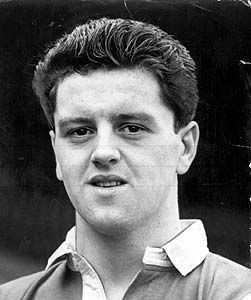
Whilst United were competing on all fronts, Taylor still had international commitments. In December 1956, he scored a hat-trick in a World Cup qualifier against Denmark. Oddly, this achievement inspired Henry Rose of the Daily Express to be critical of his play, entitling his piece: ‘If Tommy Taylor Is England’s Best Centre-forward, Then I’m Santa Claus’. Today, this type of comment would no doubt cause outrage on Twitter and bring a sharp response from the player, but Tommy simply kept his counsel. Instead, the criticism Rose received from United and their supporters led him to arrive at their next home game dressed in a Father Christmas suit by way of apology.
Taylor spent a few weeks out injured due to a cracked shin from mid-February 1957, possibly incurred due to his aversion to shin-pads, but he recovered in time for the key matches towards the end of the season. The championship was clinched in April, with Tommy once again scoring the winning goal in the key match to make it 22 from 32 appearances, so the question now was whether United could do the double. Tommy had been rushed back after his injury, so he missed the last three games of the league season to make sure he was fully recovered. The Reds went into the Cup Final against FA Cup specialists Aston Villa as favorites, but everything was turned on its head after 6 minutes when Villa striker Peter McParland challenged United keeper Ray Wood. Concussion and a fractured cheekbone resulted, and with no substitutes allowed, Jackie Blanchflower was forced to go in goal, with United going down to 10 men. This is one of those rare games from the era of which some clear video remains, and two things are immediately apparent from watching the highlights. Firstly, Taylor and his team-mates were trying too hard, especially in the first half. There are a number of examples of good possession being squandered through poorly chosen or misplaced passes. The absence through injury of Dennis Viollet was probably a factor here. Secondly, Tommy was not at his sharpest, probably as a result of the amount of football he had missed in the preceding months. Naturally, it was McParland who scored two second-half goals which put Villa in charge. United continued to press, eventually bringing Wood back on to free up Blanchflower to supplement the attacking efforts. With 10 minutes to go, Taylor finally scored with a looping header and came close shortly afterward, but ultimately the double was not to be.
Following the disappointment of the Cup Final, Taylor played in three World Cup qualifiers for England. His sharpness had clearly returned, as he scored five times in these games to help the team clinch qualification for the 1958 World Cup. Tommy’s reputation was now growing internationally, and Inter Milan decided that he would be the ideal player to lead their attack. They offered United a record fee of £55,000, plus £10,000 for the player himself. Remembering that even top players were not particularly well remunerated in England at the time, it is easy to see why Tommy would have found this offer appealing, and he was quoted in the press as saying the money was too much to turn down. Unfortunately for Taylor, Matt Busby was adamant that his center-forward was going nowhere, and, following a bizarre spell when Tommy was told to go into hiding to avoid the press, it became apparent that the move to Italy would not happen.
As the 1957/58 season got underway, Busby believed that this might be the year in which his young team would conquer Europe. In the league, a strong start was followed by a few slip-ups which left them trailing Wolves. Busby responded by making a few team-changes, including the introduction of new goalkeeper Harry Gregg. Tommy was never dropped by the United boss, presumably because he worked hard for the team and was reliably prolific. At the international level, there were a few questions being asked, as he had often been played out of position and looked less convincing than he did for United. Nonetheless, he was selected to play at center-forward in what would turn out to be his last appearance for his country in a match against France at Wembley on 27 November 1957. Taylor responded to this show of faith with a strong all-round performance, scoring twice.
Busby’s team changes got United back on track in the league as they chased Wolves, so the focus temporarily turned to Europe. In the preliminary round, the Reds had brushed aside Shamrock Rovers, and this was followed by a more challenging tie against Dukla Prague, which was won 3-1 on aggregate. A quarter-final against Red Star Belgrade would follow. Red Star was a strong side, being supported by the Yugoslav state, despite the domestic shortages caused by Tito’s communist system. United earned a 2-1 victory over the Yugoslavs in the home leg. Pausing to beat Arsenal 5-4 at Highbury, with two goals from Taylor, Busby’s young team headed to Belgrade for the return in snowy conditions. When they arrived, they were shocked by the difficulties people had in obtaining everyday goods, such as shoes, but they knew they were in for a tough game. When United went three up before the break it seemed that this might not be the case, but Red Star leveled at 3-3 in the second half and United was hanging on at the end. Nonetheless, they won the tie, and, after an evening of celebrations, they headed back home the following day. Conditions were still poor, but when the plane stopped in Munich to refuel there was no cause for alarm.
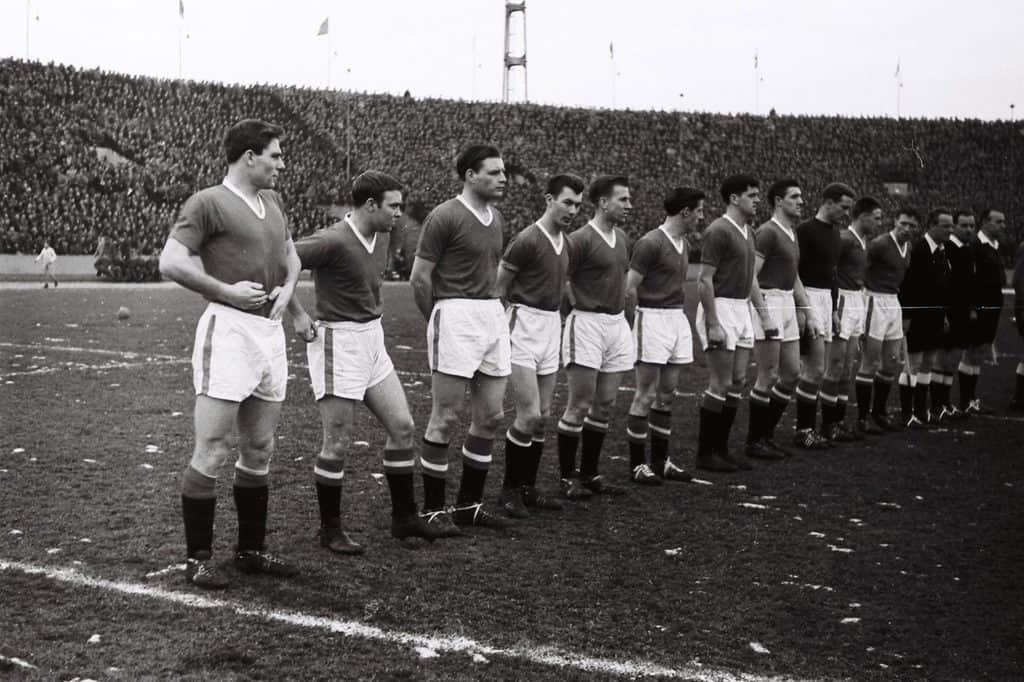
Tommy Taylor – Munich
The story of the Munich air crash has been told many times, but essentially the refueled plane was having trouble taking off due to the poor conditions. The passengers were taken off after two abortive attempts and then sent back for a third. The players had heard that in the event of a crash those at the rear of the plane had a better chance of survival, so Tommy and David Pegg, who were near the front, asked Bobby Charlton and Dennis Viollet to swap places so they could sit close to the back. This proved to be a fatal error, as the plane failed to climb sufficiently and struck a house, causing the rear section to break away and burst into flames. Tommy was apparently in the toilet when the crash occurred, but it is unlikely he would have stood a chance if he had been seated. He was one of eight players who died in the disaster. It was more than 24 hours later that his devastated family received confirmation of his death. He was finally buried at Monk Breton Parish Church a week after the crash, on 13 February 1958.
Tommy Taylor the Man
This biography has covered Taylor’s career in some depth, but what was he like as a person? There are many quotes from his contemporaries to go by, and the consensus appears to be that he was a somewhat mischievous and cheeky character who enjoyed a laugh and a joke. If the United players were heading out on the town, Tommy and his sidekick and good friend Jackie Blanchflower would normally be the ringleaders. In his career, he worked hard and would continually strive to better himself. He was always prepared to put in extra work on the training ground if there was something he wanted to improve. He was an imposing physical specimen who was always prepared to protect his team-mates on the field and would also stand up for what he felt was right if he considered that a friend or colleague was being mistreated off the pitch.
In his personal life, Tommy enjoyed female company, but, although he was never married, he was keen to commit to a serious relationship. His first real girlfriend was Norma Curtis, whom he met while he was at Barnsley. She helped him to decide about joining United, and he proposed to her prior to going on the tour of North and South America in 1953. As she was only 17 at the time, she asked him to wait until she was 18, but the difficulties in communicating with someone traveling around, thousands of miles away, led Tommy to erroneously believe that she was not writing to him. A few more communication problems and false rumors caused them to break upon his return.
In 1957 Tommy met the last love of his life, Carol Philipson, a Manchester girl. They would spend long hours chatting in local cafes, and clearly had a relationship that was built on friendship. On Christmas Eve 1957, they became engaged, with the wedding planned for June or July. Carol would eventually inherit Tommy’s sports car, but this was of little use to her as she could not drive!
Tommy Taylor – Legacy
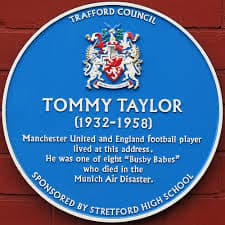
Due to Tommy’s tragic early death, he received much less recognition than he would have done if he had had more years at the top. Nonetheless, he leaves a legacy of memories for everyone lucky enough to have seen him play, and his incredible goalscoring record can never be erased. In his career, he accumulated 176 goals in 253 club and international appearances. What is more remarkable is that he had missed so much football during his short career, and was still improving. Who knows how many goals he might ultimately have scored? It is very difficult to compare across eras, but he was undoubtedly one of the all-time greats. More than 60 years after his death, there is talk of a £100,000 statue being erected to honor him in Barnsley. This would certainly be a well-earned tribute to a truly remarkable sporting figure.

